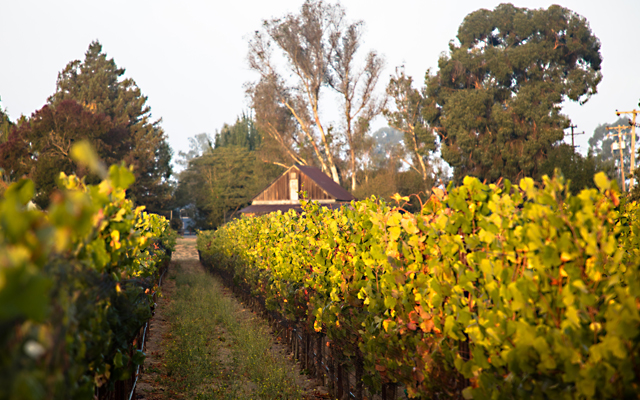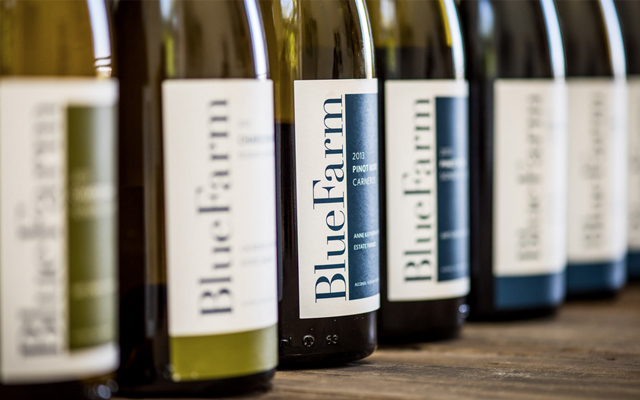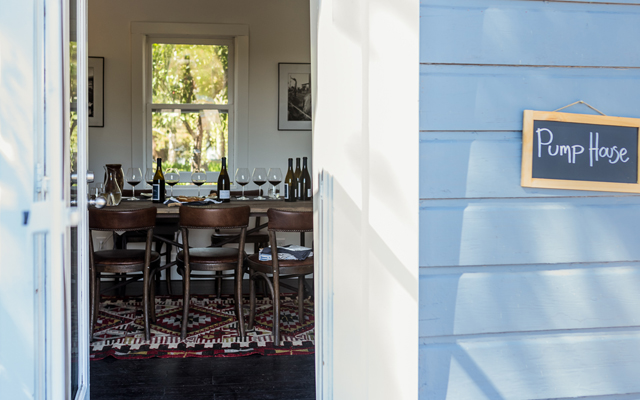Anne Moller-Racke, Blue Farm Wines
Harmony in the Vineyard
How do you define balance in wine? Is it the aromas, the structure, the acidity? You can argue that great wine, and balance is made in the vineyard. This is what you find at Blue Farm Wines. Tucked away on a side road in southwest Sonoma is a picturesque blue Victorian home surrounded by vineyards, willow trees and a pond, a true picture of harmony.
Anne Moller-Racke is the owner, winemaker, viticulturist, and wearer of many hats at Blue Farm Wines. She originally moved to California from Germany to work a harvest at the famed Buena Vista Vineyard in 1981. After an incredibly successful career, she decided to purchase seven acres to plant her own vineyard. Those seven acres not only became her home, but the home of Blue Farm Wines as well.
“Here in the US, there is such spirit.” Anne said. “In the 1980s and ’90s it was really that new frontier and you could grow any variety, any spacing. As long as you did it well, the market supported it. In the US, we are not as restricted by the laws and rules as in Europe, which gives us more room for creativity.”
Anne Moller-Racke is a winemaker who is as comfortable in the cellar as she is in the vineyard. “It’s about balancing the plant and that block within the vineyard. The little touches that you can’t do with a machine. It’s all done by hand. I don’t even like leaf pulling with a machine. It can damage the skin, the berries are so tender at this growing stage. But wine is not only grown in the vineyard, it is made in the cellar. Understanding your site, you know how extractive or gentle you want to handle the fruit. One size does not fit all. We have a tailored treatment in the vineyard and the cellar to achieve balance in a wine. Pinot Noir is fickle, and expresses the work so clearly.”

Viticulture can sound romantic, but it is much more than frolicking through the fields. Looking at the biological stage of the grapes in each vineyard is incredibly important to the final wine. “That is why you want to see where your phenology is. You need to have an idea so you can make better farming decisions. There is so much within that. If each berry is uneven from cluster to cluster, then suddenly all you have is noise instead of them all singing the same note. Once you tune it, then you get concentration in the wine. That is where the work is – in terms of really being committed.”
In some regions of the world, winemakers will blend other varieties together to make a finished wine. Cabernet Sauvignon and Merlot are a common example. With Pinot Noir however, it is more common to blend different clones. Throughout history, Pinot Noir is known to naturally mutate. Within one vineyard, you can often find multiple clones.
“Blending the clones is to have certain traits. For example, some clones are more perfumed or floral. Whereas the Swan clone is more textural. Some, like the 777 and 667 are more tannic and give structure. I planted my vineyard with the clones to make one wine. Using the clones is similar to paint, it’s all red but different shades of red. By blending the clones, you can create a more complete wine. Sometimes there is just one clone that doesn’t need anything else. It has this clear, beautiful voice and wants to stand alone. Sometimes they want to be part of the orchestra, and sometimes you have a lead opera singer.”
It is common to hear of people comparing wines from California to France, and Burgundy specifically. Anne has a unique perspective on this. “Certainly, the home of Pinot Noir is Burgundy. I’ve asked the question: what if California would have made it first? How would the French be making their wine now? I find it interesting that we always look to who did it first, they get to write the first chapter on it.”

“I want to make wines that are delicious. I cannot make Burgundy. I can make my wine. What I like about wine is the abstract. I like good acidity, structure and mouth feel. I don’t want my wines to be shrill, but I don’t want them to be jammy or diluted either. We have different soils and a different climate than France. I think we should each have our own identity. It is as if you tried to compare Picasso and Monet. They are both beautiful, just different styles.”
The wines of Blue Farm Wines, perfectly showcase the unique regions and microclimates of Sonoma County. The wines maintain an elegance and a grace that can sometimes be hard to find in a warmer climate such as California. Treating each vineyard, each block, and each plant is reminiscent of an artist tuning their instrument. Every string so painstakingly looked over and cared for; each artist balances their individual piece in the music. When the conductor finally brings it all together it brings harmony to everyone listening. This is the experience of Blue Farm Wines.

You can visit Blue Farm wines by making a reservation at www.bluefarmwines.com as well as see them at the Pigs & Pinot festival in Healdsburg, California where they will be showcasing their wines on March 17th & 18th.
Anne Moller-Racke photo by Dawn Heuman